
Students will research a place to create a travel blog to entice their audience to visit this place.
- Subject:
- English
- Writing
- Material Type:
- Assessment
- Author:
- Deb Wilkinson
- Date Added:
- 03/28/2021

Students will research a place to create a travel blog to entice their audience to visit this place.

This lesson plan explores elements of wonder, distortion, fantasy, and whimsy in The Nursery "Alice," Lewis Carroll's adaptation for younger readers of his beloved classic Alice's Adventures in Wonderland.

Using the picture book The True Story of the Three Pigs by A. Wolf as told to Jon Scieska, students will complete math word problems that cover the measurement SOLs. They will also write their own “true story” of another fairy tale, which covers the English writing SOLs. An extension of this unit could be to have students create math word problems based on their new story and have their classmates solve them. This lesson can also be used as an art activity if the story is illustrated. If technology is available, it can be an opportunity for students to practice their computer skills to create a final version of their new illustrated fairy tale or to use the computer to illustrate it.

This lesson introduces 9-12 grade students to the tuple data type using Python. Students will learn what tuples are and how to create and use them.

In this lesson, students will practice sorting sentence types as well as writing sentences based on Science SOL 5.3 - Force and Motion.
Students will also practice turning statements into questions and questions into statements based on force and motion.
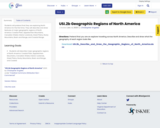
Students will pretend that they are exploring North America for the first time. They will describe and draw features of major geographic regions of North America: Coastal Plain, Appalachian Mountains, Canadian Shield, Interior Lowlands, Great Plains, Rocky Mountains, Basin and Range, and Coastal Range.
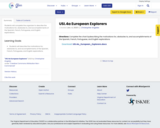
Students will complete the organizer to describe the motivations for, obstacles to, and accomplishments of the Spanish, French, Portuguese, and English explorations.
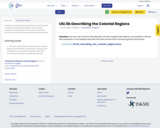
Students will complete the organizer by describing life in the New England, Mid-Atlantic, and Southern colonies, with emphasis on how people interacted with their environment to produce goods and services
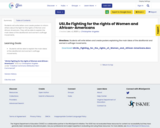
Students will write letters and create posters to inform others about the fight for the rights of Women and African Americans. They will be able to explain the main ideas of the abolitionist and women’s suffrage movements.
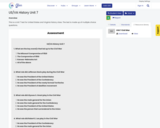
This is a Unit 7 test for United States and Virginia history class. The test is made up of multiple choice questions.
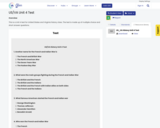
This is a Unit 4 test for United States and Virginia history class. The test is made up of multiple choice and short answer questions.
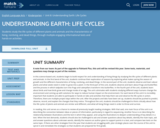
In this science-based unit, students begin to build respect for and understanding of living things by studying the life cycles of different plants and animals. In the first bend of the unit, students continue their exploration of seasons by exploring what makes spring the season of growth and the different characteristics of living, nonliving, and dead things. In the second part of the unit, students observe and learn about plants and what seeds need in order to grow into a plant. In the third part of the unit, students observe and learn about frogs and butterflies and the process in which tadpoles turn into frogs and caterpillars transform into butterflies. In the fourth part of the unit, students learn about birds and how birds grow and change inside of an egg. The unit culminates with students studying different ways humans change the environment and coming up with solutions for ways to reduce human impact on the environment. For each bend of the unit it is incredibly important that students are able to participate in hands-on labs and activities that help them see and observe the life cycles in action. Therefore, there are multiple project days within the unit. After the projects and labs have been set up, students should be pushed to predict, observe, record, and explain the changes that they notice. Throughout the unit, students should be challenged to think critically about how the life cycles of plants and animals are similar and different, and what all living things need in order to thrive and survive.
In reading, this unit serves as a chance to review all previously taught reading strategies. With that said, one main focus of the unit is on describing the connection between ideas or pieces of information, particularly in regard to sequencing. Another focus is on describing the relationship between illustrations and the text in which they appear, and using the illustrations to deepen understanding of key details in a text. When the text demands, students should also be challenged to ask and answer questions about key details, identify the main topic, ask and answer questions about unknown words, identify the reasons an author gives to support points in a text, and compare two texts on the same topic. If there are other strategies from the year that students are struggling with, plan strategic places over the course of the unit to spiral in and remediate the strategies so that students are prepared for first grade.
In writing, the main focus of this unit is on ensuring that all students are scoring a 3 or a 4 on the reading response rubric. Therefore, targeted whole-group and small-group mini-lessons should be planned based on student needs.
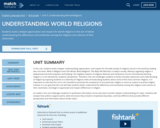
In this unit, students build a deeper understanding, appreciation, and respect for the wide variety of religions found in the world by reading two core texts: What Is Religion? and One World, Many Religions: The Ways We Worship. In today's society, illiteracy regarding religion is widespread and fuels prejudice and bullying. The negative impacts of religious illiteracy and intolerance can be minimized by teaching religion in a non-devotional, academic perspective. Therefore, this unit challenges students to build a broader awareness and understanding of religion by exposing students to a diversity of religious views and educating students about some of the most common religions. It is important to note that this unit is not intended to promote the acceptance of one particular religion or serve as a place to practice religion. Instead, it is our goal that this unit will help students better understand the differences and similarities among the religions and cultures of their classmates, and begin to appreciate and respect differences in religion.
As readers, this unit challenges students to synthesize information across two texts to build a deeper understanding of a topic. Students will analyze how authors support points, what structures they include to emphasize key ideas, and how different texts provide different perspectives and information about similar topics.

In this unit, students explore the relationship between living things and their environment and how the environment can both positively and negatively impact a species' ability to survive. Using the Next Generation Science Standards as a guide, students will learn about different species, what they need for survival, their life cycle, and how they have adapted for survival. Then students will be challenged to create arguments that explain why some organisms are able to survive well, some survive less well, and others can't survive at all in certain habitats. Through this unit, along with others in the sequence, students will use the scientific information they learn to think critically about the world around them.
The Science of Living Things texts were chosen as mentor texts for this unit because the author, Bobbie Kalman, uses text features and clear language to clearly communicate complex concepts about the animal kingdom, life cycles, and animal adaptations. As readers, students will be challenged to constantly ask and answer questions about key details in the text, explicitly referring to the text to support an answer or a question. Over the course of the unit, students will also deepen their understanding of how Bobbie Kalman uses text features to not only organize information, but to help a reader learn new information and facts about a subject. Students will also work on using context clues to figure out the meaning of genre-specific vocabulary, find the main idea of a section, and explain cause and effect in relation to scientific concepts.
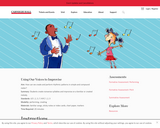
Students create nonsense syllables and improvise on a familiar or created melody.
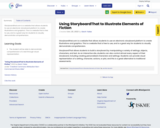
Storyboardthat.com is a website that allows students to use an electronic storyboard platform to create illustrations and graphics. This is a website that is free to use, and is a great way for students to visually demonstrate comprehension.
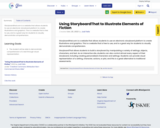
Storyboardthat.com is a website that allows students to use an electronic storyboard platform to create illustrations and graphics. This is a website that is free to use, and is a great way for students to visually demonstrate comprehension.
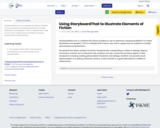
Storyboardthat.com is a website that allows students to use an electronic storyboard platform to create illustrations and graphics. This is a website that is free to use, and is a great way for students to visually demonstrate comprehension.

Storyboardthat.com is a website that allows students to use an electronic storyboard platform to create illustrations and graphics. This is a website that is free to use, and is a great way for students to visually demonstrate comprehension.
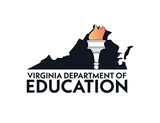
VDOE Design Challenge Common Rubric Grades 3-5 to be used when assessing performance tasks and assessments.